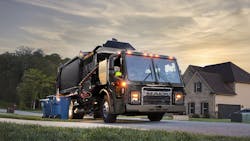Mack introduces Range Calculator for EVs
Mack Trucks recently introduced its Range Calculator for Electric Vehicles to help customers simulate real-world collection routes. This information allows customers to plan and build routes for the Mack LR Electric refuse vehicle based on many route-specific variables.
The Range Calculator for Electric Vehicles takes into account the battery capacity, refuse body application type, ambient temperature, terrain, and the amount of stops on a specific route. This enables customers to estimate and plan for the energy that will be consumed on the route.
“The Range Calculator for Electric Vehicles is a useful tool for customers and potential customers so when they’re making the decision about whether to purchase an electric vehicle, they can easily plan collection routes that will be best suited for the vehicle,” said Scott Barraclough, Mack Trucks senior product manager of e-mobility. “The tool is easy to use and can predict when the vehicle should need to be charged, if necessary, so that the proper planning can be made.”
Using GPS data collected from the customer’s current routes, Mack is able to utilize the data to produce a detailed report predicting the number of starts and stops the Mack LR Electric can fulfill on the specific route. The calculator takes into account increasing payload, regenerative braking, and the time spent at each stop.
Customers interested in the Range Calculator for Electric Vehicles can speak with their local Mack dealer.
See also: Mack LR Electric ride and drive
The next generation LR Electric, which was launched in March 2022, features 42% more energy and a standard 376 kWh total battery capacity for increased range. The Mack LR Electric features twin electric motors, offers 448 continuous horsepower and 4,051 lb.-ft. of peak output torque from zero RPM. The LR Electric has a two-speed Mack Powershift transmission, Mack mRIDE suspension, and Mack’s proprietary S462R 46,000-lb. rear axles.
The LR Electric is equipped with four NMC (Nickel Manganese Cobalt Oxide) lithium-ion batteries that are charged by a 150kW SAEJ1772-compliant charging system. Along with vehicle propulsion, the four batteries also provide all power for every onboard accessory, driven through 12V, 24V, and 600V circuits. The two-stage regenerative braking system helps recapture energy from the hundreds of stops the vehicle makes each day with an increasing load.
The LR Electric features a copper-colored Bulldog on the cab signifying the electric drivetrain, making it easily identifiable. The Mack LR Electric may be fitted with equipment bodies from numerous manufacturers based on the unique needs of the customer. The same driver/passenger side driving configurations, as well as seating choices and door options, are offered in the LR Electric as on the diesel-powered Mack LR model.
